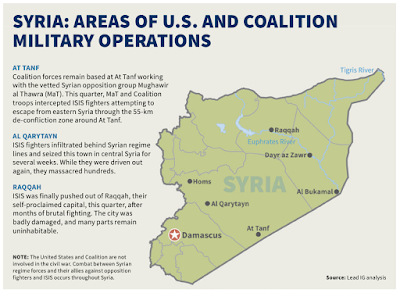
This article was last updated on April 16, 2022
Canada: ![]() Oye! Times readers Get FREE $30 to spend on Amazon, Walmart…
Oye! Times readers Get FREE $30 to spend on Amazon, Walmart…
USA: ![]() Oye! Times readers Get FREE $30 to spend on Amazon, Walmart…
Oye! Times readers Get FREE $30 to spend on Amazon, Walmart…
With the Trump Administration making its first moves toward punishing Syria and Bashar al-Assad for its alleged use of chemical agents in Douma, the mainstream media is touting this as the exception rather than the rule; one of the few times that the United States has actually overtly involved itself in Syria’s civil war. Such is complete nonsense and the federal government’s own data shows how long and how involved the United States Department of Defense has been involved in a war to which is was not invited.
Thanks to the Department of Defense (DoD) and the Lead Inspector General’s reports to Congress, we can get relatively current data on Operation Inherent Resolve (OIR), the Department’s operations to clear ISIS from both Syria and Iraq. In the latest report from the Office of the Inspector General for the quarter from October 1, 2017 to December 31, 2017, we find the following map showing areas of operation by the United States and its coalition:
According to the report, DoD claims that there were about 2,000 U.S. troops deployed in Syria, a four-fold increase over its previous report that roughly 500 personnel were in-country. The troops are in Syria to advise, train and equip members of the Syrian Democratic Forces (SDF), an alliance of Kurdish (the dominant group – YPG/PKK), Arab, Turkmen, Assyrian and Armenian militias that are fighting against both ISIS and al-Nusra. U.S. soldiers are also being used to train at least one Syrian opposition group (opposed to Bashar al-Assad) at the At Tanf garrison on the Jordanian/Syrian border. During fiscal 2017, the DoD estimates that it trained about 2,400 individuals belonging to 3 vetted Syrian opposition groups and more than 12,500 members since late 2016, including more than 11,000 members of the SDF.
Here is a summary of activities at the two training locations:
“U.S. Special Forces and partner forces continued to train the Mughawir al Thawra (MaT), a vetted Syrian opposition group, at the At Tanf garrison.128 However, this group, originally conceived as a force to fight ISIS, was confined to patrolling the 55-kilometer “de-confliction zone” that surrounds the garrison, and providing screening to protect logistical convoys. At least twice this quarter, MaT fighters confronted ISIS fighters who breached the zone perimeters, the DoD reported. In 2017, about one dozen MaT fighters defected to the Syrian regime, but the DoD reported this quarter that there have been no further defections.
It was not clear how many vetted Syrian opposition groups or their members were trained at al Bab. The DoD reported only that training was occurring there.” (my bold)
Here is the Department’s assessment of the effectiveness of the SDF:
“The DoD reported that the SDF had shown more battlefield successes than any other vetted Syrian opposition force. It credited the force not only with liberating territory from ISIS’s control, but also with pushing ISIS from the Turkish border to prevent foreign fighters from using international crossings. The DoD reported that the SDF liberated an area the size of Vermont and New Hampshire and predicted that the SDF would clear ISIS from land east of the Euphrates River, effectively ending ISIS’s physical caliphate in Syria. According to the DoD, the SDF had demonstrated both offensive combat capabilities and the ability to hold terrain after it was liberated from ISIS. The SDF have also borne the brunt of the casualties in the fight against ISIS.”
By mid-Decembe 2017, U.S. military officials estimated that only 3 percent of Syria remained under the control of ISIS (Washington’s stated reason why it was involved in combat operations in Syria) and that there were only about 3,000 ISIS fighters remaining in Syria including those in the villages on the easter side of the Euphrates River in Dayr az Zawr province, in slivers of territory in Hassaka, Homs, Hama and Daraa provinces, the Yarmouk Palestinian refugee camp in Damascus, two Damascus suburbs and near the Golan Heights as shown on this map:
The report does comment on Russia’s presence in Syria (keeping in mind that the Assad regime actually invited Russia to assist Syrian government forces whereas the United States is an uninvited guest) as follows:
“Russia’s presence in Syria continued to complicate Coalition operations against ISIS. While there were no examples of Russian or Coalition forces firing on each other this quarter, challenges continued in efforts to de-conflict air and ground operations. Moreover, Russia continued to call for U.S. troops to withdraw from Syria, even as it expanded its military presence at two Syrian bases. The DoD estimated that approximately 3,000- 5,000 Russian military personnel and an unknown number of private Russian contractors fought alongside Syrian regime forces. Russia also deployed military police to the city of Homs, establishing checkpoints and observation posts and contributing to a reduction of violence.
United States and Russian officials communicated over the de-confliction hotline as many as 20 times per day, according to Coalition officials. However, Russian aircraft engaged in behavior that risked collision with Coalition aircraft, officials said. In December, in one of the most dramatic incidents, two U.S. airplanes stopped supporting operations against ISIS to intercept two Russian aircraft that had crossed into airspace patrolled by U.S. aircraft, almost colliding with one of them. According to the DoD, Russian aircraft have also flown through no fly zones previously agreed to by Coalition and Russian representatives, increasing the risk of unintentionally firing on Coalition ground forces. Russian forces have also fired artillery into ISIS-held territory in close proximity to Coalition forces.
In October, during offensives into ISIS territory, by both the SDF and the Syrian regime, Coalition officials warned Russia against attacking or colliding with the SDF, with a spokesperson stating that the U.S. military was “prepared to defend our partners if they are attacked, whether by ISIS fighters or by anyone else. We certainly don’t want to come to that and we will continue to de-conflict with our Russian partners.”” (my bolds)
The report also had this to say about the connection between Russia and Iran:
“According to the DoD, while Iran and Iranian-backed forces in Syria operate independently of the Syrian military in terms of command and control, they usually closely coordinate their operations with Russian and regime forces. Underscoring the significance of Iran’s presence in Syria, the Iranian Armed Forces Chief of Staff visited positions in Aleppo in mid-October. In briefings to reporters, U.S. officials asserted that as much as 80 percent of the Syrian regime’s combat manpower was provided by Iranian- backed groups.” (my bold)
While the data is for Operation Inherent Resolve is not divided by nation (i.e. Syria vs. Iraq), here is the U.S. Air Forces Central Command Combined Air Operations Airpower Summary for the month of January 2018:
As you can see, there have been 105,756 weapons released by the U.S. Air Force so far during the four years that it has been involved in Operation Inherent Resolve if we include the 6,292 weapons that were dropped between August and December of 2014. While we can’t divide the weapons dropped by nation, this gives us some idea of the split in the number of airstrikes between Iraq and Syria up to August of 2017:
Here is a look at the average daily cost and total cost of Operation Inherent Resolve up to June 30, 2017 noting that operations in Syria began on September 20, 2014 and that this is the latest report that I can find online:
As you can clearly see, the United States military has been involved in Syria for nearly four years as an uninvited guest, a position that is actually against Article 2 (4) of the Charter of the United Nations which states that:
“All Members shall refrain in their international relations from the threat or use of force against the territorial integrity or political independence of any state, or in any other manner inconsistent with the Purposes of the United Nations.”
But, I guess when you’re the biggest “kid on the block”, you can just invite yourself to the “party” and no one will really object, at least not if they know what is good for them. After all, the United States is involving itself in yet another example of extrajudicial international vigilantism.
Click HERE to view more.
You can publish this article on your website as long as you provide a link back to this page.

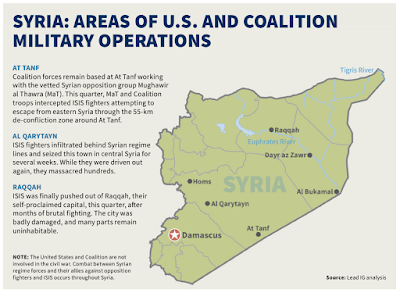
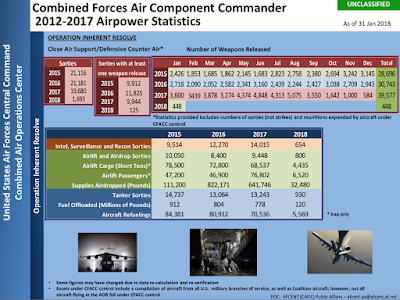
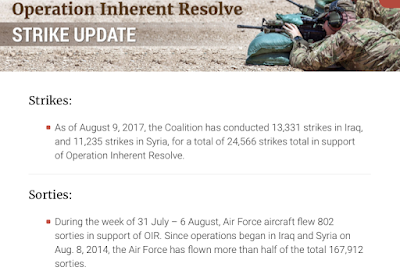
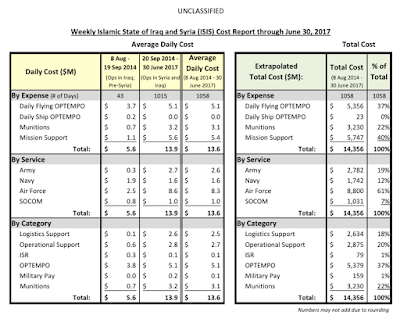
Be the first to comment